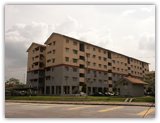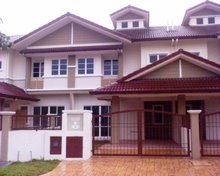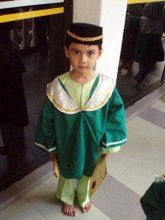Tuesday, May 8, 2007
Sunday, May 6, 2007
Fast Facts About Malaysia
Country
The Federation of Malaysia comprises Peninsula Malaysia and the states of Sabah and Sarawak on the island of Borneo.
Geographical Location
Located between 2º and 7º north of the Equator, Peninsula Malaysia is separated from the states of Sabah and Sarawak by the South China Sea. To the north of Peninsula Malaysia is Thailand while its southern neighbour is Singapore. Sabah and Sarawak are north of Indonesia in Borneo while Sarawak also shares a border with Brunei.
Area
329,758 sq km
Population
26 million
Capital
Kuala Lumpur
People
Malays who make up about 57% of the population are the predominant group with Chinese, Indians and other ethnic groups making up the rest.
Language
Bahasa Melayu (Malay) is the national language but English is widely spoken. The ethnic groups also speak various languages and dialects.
Religion
Islam is the official religion but all other religions are freely practised.
Government
Malaysia is governed by a Parliamentary democracy with a bicameral legislative system. The Head of State is the Yang Di-Pertuan Agong, a position that is awarded to a different State Monarch every five years and the Head of Government is the Prime Minister.
Climate
Tropical climate with warm weather all year round. Temperatures in the lowlands range from 21ºC (70ºF) to 32ºC (90ºF). The highlands are cooler, where temperatures range between 15°C (59° F) to 25°C (77°F). Annual rainfall varies from 2,000mm to 2,500mm.
Major Holidays
New Year's Day Hari Raya Aidiladha* Federal Territory Day ** Chinese New Year* Awal Muharam* Birthday of Prophet Muhammad* Labour Day* Wesak Day* King's Birthday* National Day* Deepavali# Hari Raya Aidilfitri* Christmas*Note: (*) - National holidays (**) - Putrajaya, Kuala Lumpur & Labuan only (#) - Except Labuan & Sarawak
Economic Profile
Manufacturing constitutes the largest single component of Malaysia's economy. Tourism and primary commodities such as petroleum, palm oil, natural rubber and timber are other major contributors to the economy.
Distance to Malaysia
London, United Kingdom to Kuala Lumpur : 6,557 miles (10,552 km)
Paris, France to Kuala Lumpur 6,483 miles (10,432 km)
Rome, Italy to Kuala Lumpur : 6,038 miles (9,716 km)
Stockholm, Sweden to Kuala Lumpur : 5,812 miles (9,353 km)
Berlin, Germany to Kuala Lumpur : 5,979 miles (9,622 km)
Madrid, Spain to Kuala Lumpur : 6,885 miles (11,079 km)
New York, USA to Kuala Lumpur : 9,400 miles (15,126 km)
Los Angeles, USA to Kuala Lumpur : 8,790 miles (14,144 km)
Vancouver, Canada to Kuala Lumpur : 7,944 miles (12,783 km)
Currency
The unit of currency is Malaysian Ringgit indicated as RM. USD1 is roughly equivalent to RM3.70. Foreign currency can be converted at banks and money changers.
Time
Eight hours ahead of GMT and 16 hours ahead of U.S. Pacific Standard Time.
What does the name "Khalid" mean?
My first name is Khalid. In Arabic, this is خالد. It was originally spelled Khaled with an "e", to be more in line with the Egyptian pronounciation, but at some point I decided that Khalid with an "i" is closer to the classical version. The problem is that in English, this is taken to be a long "i", as in "-leed". It is more like "lid".
Khalid is a pre-Islamic Arabic name meaning "immortal". One of the earliest famous persons called Khalid is Khalid Ibn Al-Walid, a n Arab general whose conquests against the two most powerful empires of the time (Byzantine and Sassanian) brought him everlasting fame. He is one of a few military commanders who never knew defeat in battle.
Saturday, May 5, 2007
Types of investments
The term "investment" is used differently in economics and in finance. Economists refer to a real investment (such as a machine or a house), while financial economists refer to a financial asset, such as money that is put into a bank or the market, which may then be used to buy a real asset.
Business Management
The investment decision (also known as capital budgeting) is one of the fundamental decisions of business management: managers determine the assets that the business enterprise obtains. These assets may be physical (such as buildings or machinery), intangible (such as patents, software, goodwill), or financial (see below). The manager must assess whether the net present value of the investment to the enterprise is positive; the net present value is calculated using the enterprise's marginal cost of capital.
Economics
In economics, investment is the production per unit time of goods which are not consumed but are to be used for future production. Examples include tangibles (such as building a railroad or factory) and intangibles (such as a year of schooling or on-the-job training). In measures of national income and output, gross investment I is also a component of Gross domestic product (GDP), given in the formula GDP = C + I + G + NX. I is divided into non-residential investment (such as factories) and residential investment (new houses). "Net" investment deducts depreciation from gross investment. It is the value of the net increase in the capital stock per year. Investment, as production over a period of time ("per year"), is not capital. The time dimension of investment makes it a flow. By contrast, capital is a stock, that is, an accumulation measurable at a point in time (say December 31st).
Investment is often modelled as a function of income and interest rates, given by the relation I = f(Y, r). An increase in income encourages higher investment, whereas a higher interest rate may discourage investment as it becomes more costly to borrow money. Even if a firm chooses to use its own funds in an investment, the interest rate represents an opportunity cost of investing those funds rather than loaning them out for interest.
Finance
In finance, investment is buying securities or other monetary or paper (financial) assets in the money markets or capital markets, or in fairly liquid real assets, such as gold, real estate, or collectibles. Valuation is the method for assessing whether a potential investment is worth its price. Types of financial investments include shares, other equity investment, and bonds (including bonds denominated in foreign currencies). These financial assets are then expected to provide income or positive future cash flows, and may increase or decrease in value giving the investor capital gains or losses.
Trades in contingent claims or derivative securities do not necessarily have future positive expected cash flows, and so are not considered assets, or strictly speaking, securities or investments. Nevertheless, since their cash flows are closely related to (or derived from) those of specific securities, they are often studied as or treated as investments.
Investments are often made indirectly through intermediaries, such as banks, mutual funds, pension funds, insurance companies, collective investment schemes, and investment clubs. Though their legal and procedural details differ, an intermediary generally makes an investment using money from many individuals, each of whom receives a claim on the intermediary.
Personal finance
Within personal finance, money used to purchase shares, put in a collective investment scheme or used to buy any asset where there is an element of capital risk is deemed an investment. Saving within personal finance refers to money put aside, normally on a regular basis. This distinction is important, as investment risk can cause a capital loss when an investment is realized, unlike saving(s) where the more limited risk is cash devaluing due to inflation.
In many instances the terms saving and investment are used interchangeably, which confuses this distinction. For example many deposit accounts are labeled as investment accounts by banks for marketing purposes. Whether an asset is a saving(s) or an investment depends on where the money is invested: if it is cash then it is savings, if its value can fluctuate then it is investment.
Real estate
In real property, investment is money used to purchase property for the sole purpose of holding or leasing for income and where there is an element of capital risk. Unlike other economic or financial investment, real estate is purchased. The seller is also called a Vendor and normally the purchaser is called a Buyer.
Offshore Investment
Since April 2005, peoples around the world are shocked by SwissCash International Ltd (SC). SC is an offshore investment company. It gives 25% per-month from investor principal, unlimited time! Learn it and free registration for 13 days to enjoy it's HiTech Service.
Residential Real Estate
The most common form of real estate investment as it includes the property purchased as peoples houses. In many cases the Buyer does not have the full purchase price for a property and must engage a lender such as a Bank, Finance company or Private Lender. Different countries have their individual normal lending levels, but usually they will fall into the range of 70-90% of the purchase price. Against other types of real estate, residential real estate is the least risky.
Friday, May 4, 2007
Wednesday, May 2, 2007
Anak sapa ni yeh?..
Semalam aku terima komplen pasal apa gambar dia takder. Asik gambar anak jer......hehe. Oklah, hari ni aku masukkan gambar bini aku ni. Nama dia Siti Herdawaty Binti Kamaruzaman. Umur dia 32 tahun. Bekerja sebagai Library Executive kat library PTPL. Lulusan pengurusan har tanah tapi jaga library plak kerja dia. Takpelah, apa pon masyukkkkkk.... Minggu2 ni aku tabik lah kat dia pasai rajin nak basuh baju.secara manual. Almaklumlah, anak dara korea aku dah rosak plak. Tadi cina tukang repair tu dah ambik anak dara tu tuk di repair. Ermmm dia kata 2 hari, tapi kalau tak baik gak kenalah beli yang baru. Kesian kat bini punya pasai...... Bini aku ni pantang kena puji lebih2, sebab nanti dia perasan sangat. So, stop dululah..
kat library PTPL. Lulusan pengurusan har tanah tapi jaga library plak kerja dia. Takpelah, apa pon masyukkkkkk.... Minggu2 ni aku tabik lah kat dia pasai rajin nak basuh baju.secara manual. Almaklumlah, anak dara korea aku dah rosak plak. Tadi cina tukang repair tu dah ambik anak dara tu tuk di repair. Ermmm dia kata 2 hari, tapi kalau tak baik gak kenalah beli yang baru. Kesian kat bini punya pasai...... Bini aku ni pantang kena puji lebih2, sebab nanti dia perasan sangat. So, stop dululah..
 kat library PTPL. Lulusan pengurusan har tanah tapi jaga library plak kerja dia. Takpelah, apa pon masyukkkkkk.... Minggu2 ni aku tabik lah kat dia pasai rajin nak basuh baju.secara manual. Almaklumlah, anak dara korea aku dah rosak plak. Tadi cina tukang repair tu dah ambik anak dara tu tuk di repair. Ermmm dia kata 2 hari, tapi kalau tak baik gak kenalah beli yang baru. Kesian kat bini punya pasai...... Bini aku ni pantang kena puji lebih2, sebab nanti dia perasan sangat. So, stop dululah..
kat library PTPL. Lulusan pengurusan har tanah tapi jaga library plak kerja dia. Takpelah, apa pon masyukkkkkk.... Minggu2 ni aku tabik lah kat dia pasai rajin nak basuh baju.secara manual. Almaklumlah, anak dara korea aku dah rosak plak. Tadi cina tukang repair tu dah ambik anak dara tu tuk di repair. Ermmm dia kata 2 hari, tapi kalau tak baik gak kenalah beli yang baru. Kesian kat bini punya pasai...... Bini aku ni pantang kena puji lebih2, sebab nanti dia perasan sangat. So, stop dululah..Tahun 1
Ermm.. dah 4 bulan wawan bersekolah di dalam Tahun 1 kat Sek. Raja Muda Sek 4. (aku dulu pon sekolah kat situ..first badge tahun 1982 darjah 6) Setakat ni semuanya ok cuma beg sekolah jer yang dah koyak. Perkembangannya ok kot. Aku pon tak berapa tahu pasal bila ditanya, wawan buat bodo jer taknak jawab. Tapi nampaklah perbezaan...dah boleh membaca. Kat rumah, ibunya yang rajin mengajar. Aku? hehe... aku ni malas sikit. Bukannya apa, karang kalau dia taknak dengar, mulalah aku naik angin.
Pagi sekolah agama, petang sekolah kebangsaan. Pagi aku hantar, tgh hari dia balik rumah atuknya naik van, pastu atuk dia hantar gi sekolah. Petang biasanya atuk dia amik kecuali Isnin ngan Jumaat kalau sempat aku gi amik pasal dia balik lewat 6.30 pm ngan 6.40 pm. Tiap Sabtu dia belajar Tae Kwon Do. Hari Sabtu depan ni dia ada 'grading'. Alaa test tuk naik ke tali kuning. Harap2 semuanya ok. Aku harap pelajaran Tae kwon do dia akan abis sampai tali hitam at least 'first done'. So boleh lah harapkan dia untuk pertahankan keluarga kalau aku takder...
Subscribe to:
Comments (Atom)

























